The Earth’s north pole is aligned with a point in the sky that is remarkably close to the position of Polaris. Consequently, as the Earth spins on its axis, it gives the illusion that Polaris is stationary while all the other stars orbit around it.

Taken with a Sony ILCE-7C camera and a Tamron 11-20mm f/2.8 Di III-A RXD lens, this photo captures the beauty of Polaris, the North Star. It’s fascinating to think about why Polaris always faces north and serves as a guide for navigators and astronomers alike. The ISO was set to 640, the aperture was set to F/2.8, and the shutter speed was 273 seconds.

Reply to the post “The Sun is the largest star!”
I have my own issue with Polaris. For some reason, the majority of the people I know confidently claim that Polaris is the brightest star. It takes a lot of effort to explain that it doesn’t even rank in the top 20 brightest stars in the Earth’s sky. You have to overcome their skepticism, assert your authority, show them stars like Polaris and Arcturus in the sky, and finally convince them. However, after a year, they go back to their misconception.
The other side of the coin is that for these people, Polaris is currently the brightest star in the sky. Rukalitsu.jpg.

What is the significance of Polaris?
Polaris holds a unique position directly above the Earth’s axis of rotation on the northern side. As a result, it appears almost stationary in the sky, while other stars revolve around it in circular paths throughout the night.
In the northern hemisphere, Polaris serves as a reliable guide, always pointing towards the north whenever you gaze up at the night sky.


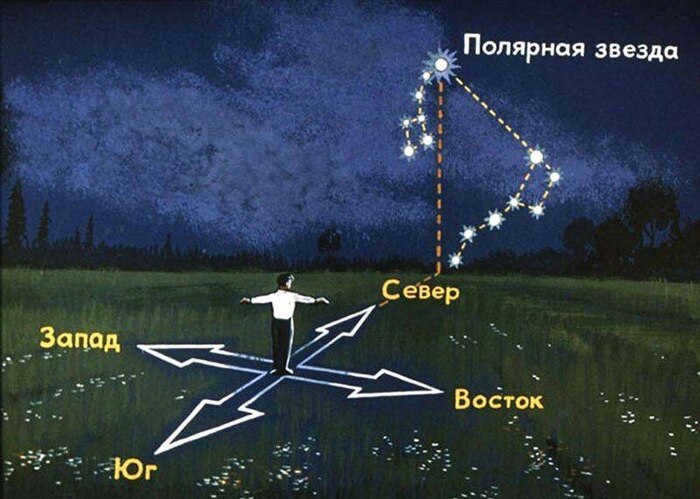
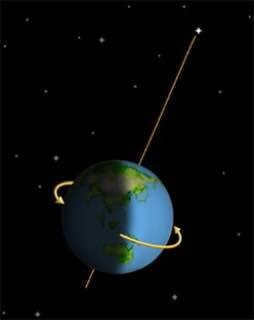
Did you go for a swim, enjoy some watermelon, or sit around a campfire? How did you spend your summer?
Even if your summer was filled with work, don’t feel disheartened. We have a fun activity that will keep you entertained all summer long! Gather a variety of summer mementos and you’ll receive a special profile on Peekaboo. Plus, you’ll discover how to make the most of summer no matter the season.

Star Circle. Captured with a Sony a6300 camera. Samyang 12mm F/2.0 NCS CS lens. ISO 2000. 32.5 minutes of exposure. Located in the Chuvash Republic.


Pole star

Polaris: The Brightest Star in the Night Sky
When we gaze up at the celestial heavens, our eyes are met with a vast tapestry of countless stars, each holding its own mysteries. Among them, Polaris shines as one of the most prominent.
While many stars are well understood by astronomers, Polaris continues to captivate and perplex us with its enigmatic nature.
Often referred to as Alpha of the Bear, Polaris remains a celestial enigma, hiding secrets waiting to be unlocked.

North Star
It shows the direction. However, its guidance is temporary.
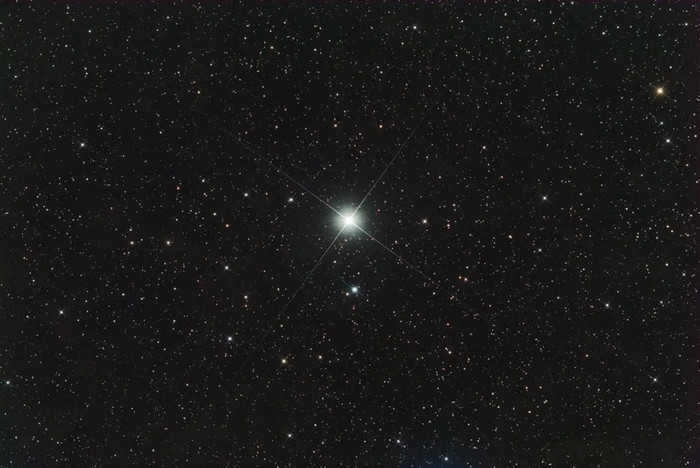
It is likely the most famous star among humans. Furthermore, its fame started to rise in ancient times when the Sun wasn’t regarded as a star. However, to be honest, her “stardom” came relatively recently by historical standards, and it is also quite fleeting.
She is believed to have some special brightness, but she is not the brightest, rather average in this regard. Some individuals believe she is the closest. However, that is also untrue. There is a belief that Polaris can be seen from everywhere on Earth, and that it can be used for navigation in all oceans and deserts across the planet. But even this is incorrect. The true reason for the significance of this celestial body is only known by those familiar with astronomy.
What makes Polaris so famous?
To begin with, Polaris is positioned on the celestial sphere at a considerable distance from the North Pole of the Earth. The North Pole is a specific point on the celestial sphere where the Earth’s imaginary rotation axis intersects with the imaginary sphere. Polaris is located very close to this point, making it a close approximation of the North Pole’s position.
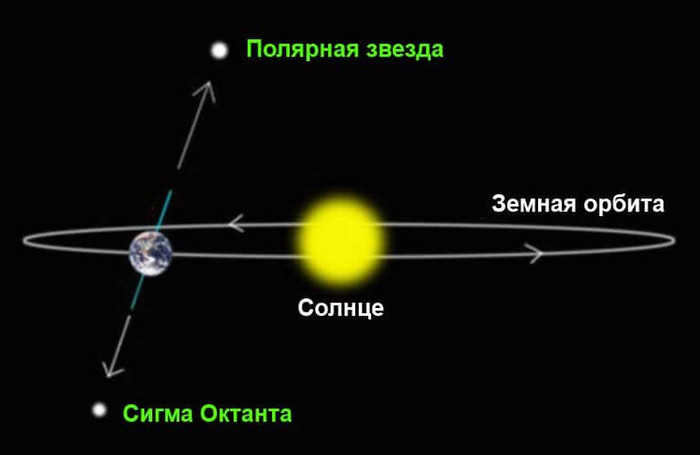
It may seem like a complex concept that requires a great deal of imagination, right?
However, the explanation is actually quite straightforward. If we extend a line from the North Pole to the South Pole of the Earth globe, and continue that line in a northern direction, it will accurately point towards Polaris.
From any location in the northern hemisphere of the Earth, we can always observe where the Earth’s axis of rotation is directed by looking at this celestial body.
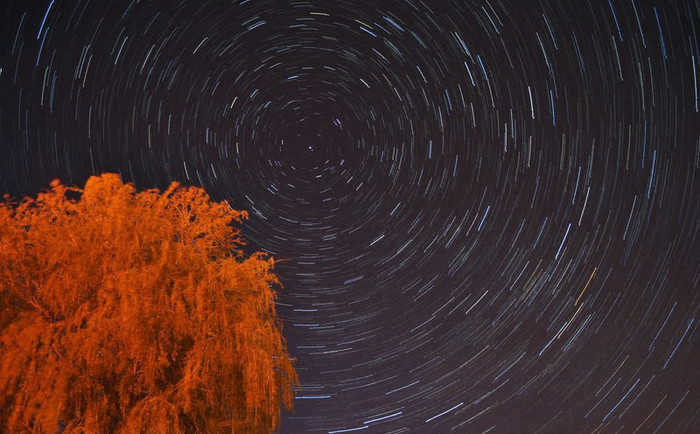
Unfortunately, in the southern hemisphere of the Earth, Polaris cannot be seen. It remains hidden from view, both in winter and summer, never revealing itself.
As a result, its usefulness for maritime navigation is limited in those regions.
However, it was precisely its navigational significance that contributed to its immense popularity. The art of seafaring began in the northern hemisphere.
Ship captains and navigators found it incredibly convenient to locate this star in the night sky, using it as a reference point to determine north, and subsequently all other directions at sea (east, south, west), where there are no other prominent landmarks, only the stars.
And the North Star, Polaris, is the only star that consistently shines above the northern point.
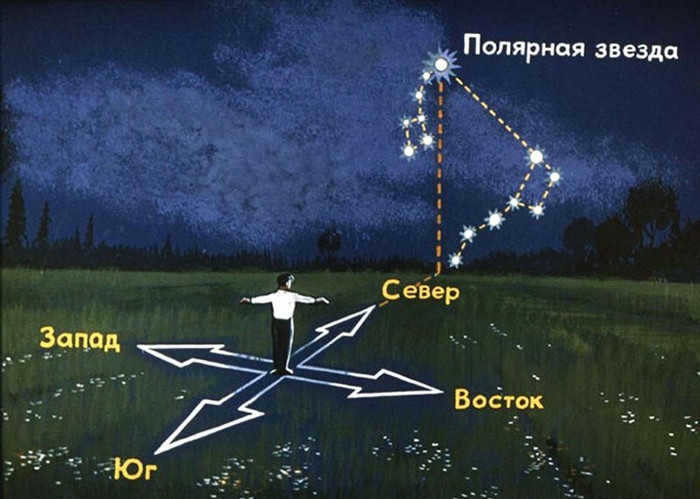
Using special tables and corrections for refraction, you can accurately determine the latitude of the observation location by Polaris with much greater precision. Instead of rounding to the nearest degree, you can now determine the latitude to the nearest one or two angular minutes, which is equivalent to a few kilometers. This level of accuracy is sufficient for locating even very small islands.
Unfortunately, Polaris does not provide any assistance in determining longitude. There are other methods for this purpose, but that is not the topic of this article.
How did Polaris come to be positioned so close to the North Pole on the celestial sphere? How long has it been in that position?
It’s mostly a game and a matter of luck. For instance, there is no star of similar brightness in close proximity to the southern pole of the globe. Navigating in the oceans and seas of the southern hemisphere used to be slightly more challenging before the advent of GPS.
And even in the northern hemisphere, a few thousand years ago, nobody used Polaris for ship navigation. It didn’t even go by that name at that time.

Polar Alpha of the Little Bear received its name relatively recently. It wasn’t until the Renaissance that it began to be called Polaris, thanks to the Dutch cartographer Gemma Friesus, who described it as “stella illa quae polaris dicitur” in one of his works in 1547. And that name stuck. Although at that time, Polaris was four times farther from the pole than it is now.
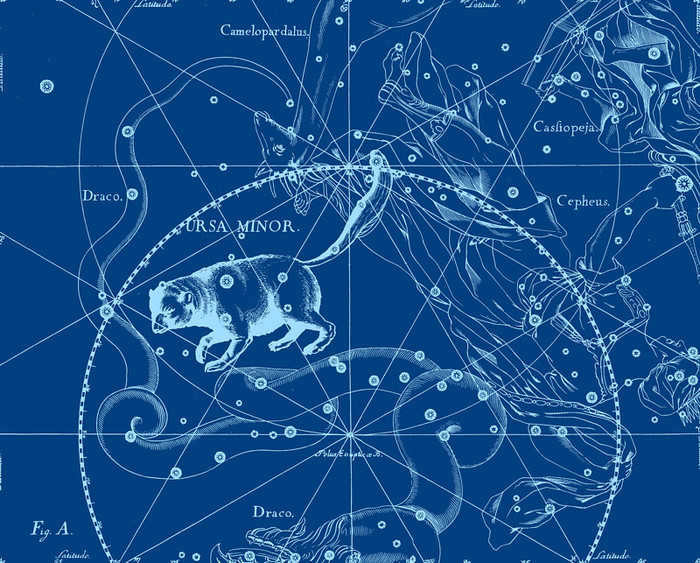
The Celts of old referred to it as the “Ship-Star” – “Scip-steorra” – a name that foreshadowed its future significance.
Similarly, the ancient Arabs, known for their extensive cataloging of celestial bodies, named Polaris “Al-Judei,” meaning “Father.” Many of these Arabic star names are still used in astronomy today, though Polaris’ original name has largely faded from memory.
Nevertheless, during the time when these ancient names were in use, Polaris was not utilized for navigation, orienteering, or related endeavors. It was situated far from the pole.
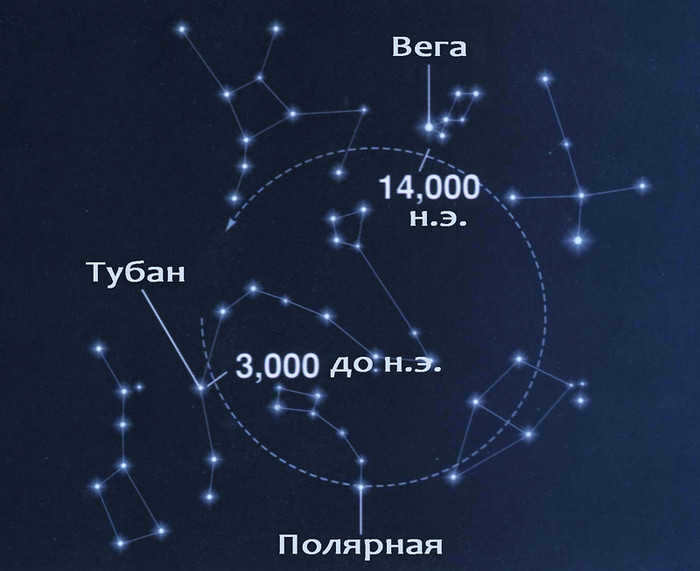
During the time of Archimedes and Pythagoras, another star known as “Kohab” in Arabic, which means “Star of the North,” played the role of the “polar star.” Even earlier, during the construction of the pyramids, the star “Tuban” – the alpha of the Dragon – was the closest to the North Pole of the World.
It is important to note that dragon constellations were not depicted on star charts during that time.
As we now understand, the North Pole of the Earth slowly moves across the star chart, shifting from one star to another, and completing a full circle every 26,000 years. Currently, it is getting closer to Polaris and will reach its closest point in 2102, which is 80 years from now. At that time, the minimum distance between Polaris and the North Pole will be 27 angular minutes, slightly less than the size of the lunar disk. However, at present, the distance is almost one degree.
In the future, Polaris will no longer be known as the “Polaris” and will be replaced by Cepheus Gamma in two thousand years. And another 10,000 years after that, the “polar” star for people in the northern hemisphere of the Earth will be the stunningly beautiful Vega, which is the alpha star of the Lyra constellation.
What else can we say about Polaris that is interesting?
As mentioned previously, this particular star is the leader of a small constellation known as the Little Bear, where it holds the title of being the alpha and the most brilliant star within it. In all fairness, the beta star of the Little Bear, commonly referred to as Cohabus, is only slightly dimmer than Polaris by a few hundredths of a star magnitude, making it practically indistinguishable to the naked eye.
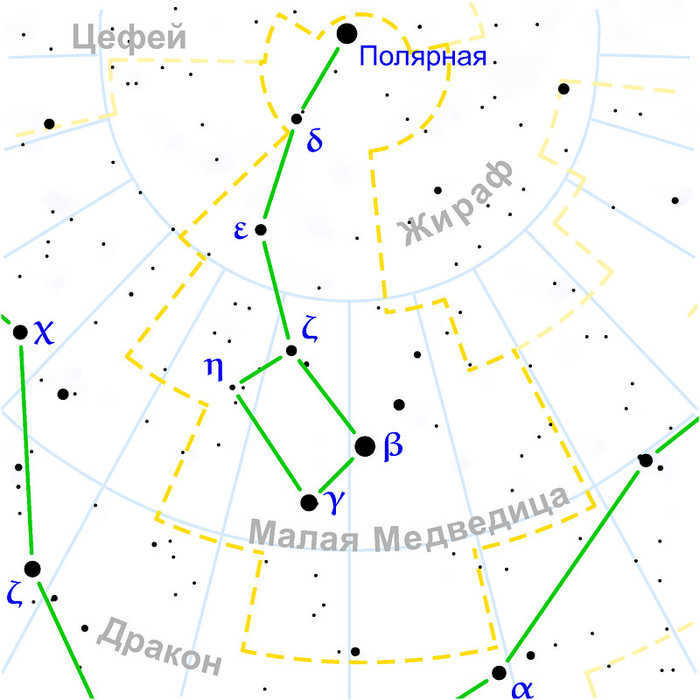
Polaris can be found using the stars in the Big Dipper constellation, whose brightness is similar to that of Polaris. By extending the line connecting the outermost stars of the Big Dipper five times, we can locate Polaris, a star of relatively moderate brightness – only 2nd magnitude.
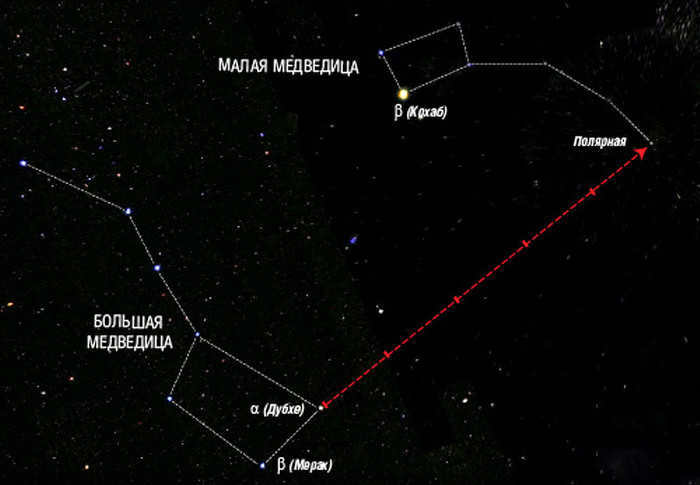
Although it may not catch the attention of the average person, Polaris is a star that has intrigued astronomers due to its distinctive characteristics and exceptional properties.
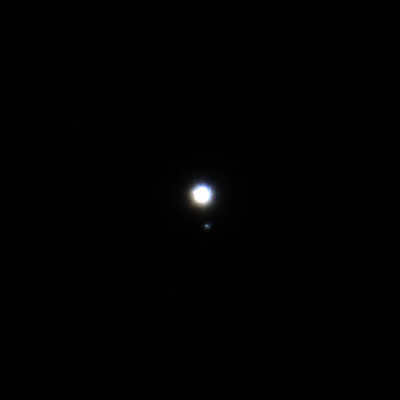
Polaris is a binary star system. When using an amateur telescope, it is possible (though challenging) to observe a faint companion star, Polaris B, with a magnitude of 8. In closer proximity to the primary star is another component of this system, Polaris Ab, which can only be observed using the Hubble telescope or a comparable one. Floating at a certain distance from this “trio” are two additional stars, moving in the same direction. Astronomers have yet to determine whether these stars are part of a stable system connected to Polaris or if they belong to an unstable scattered mini-cluster that will eventually disperse.
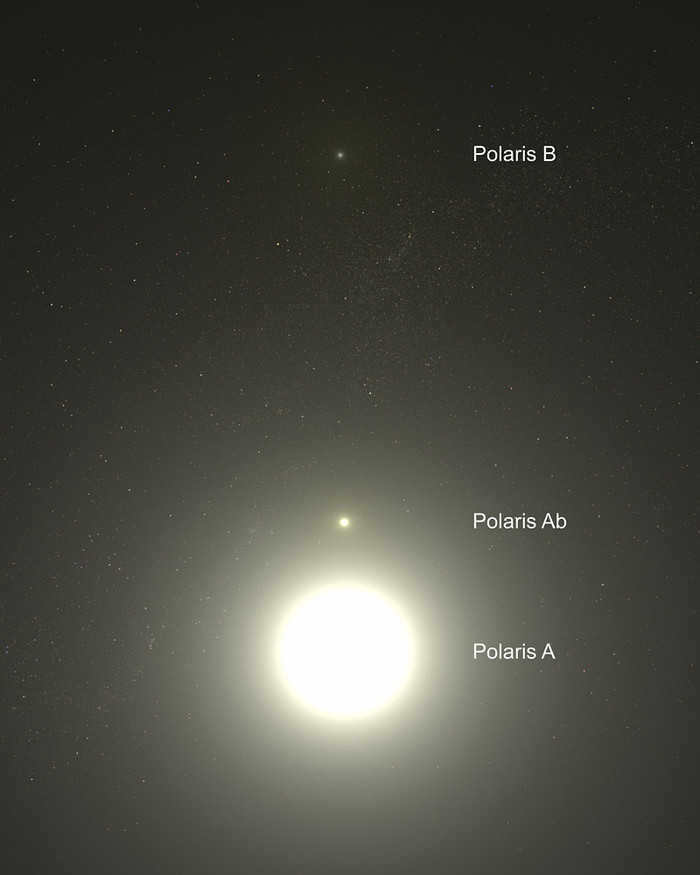
A group of stars known as the Northern Polar Series has been identified by astronomers in the vicinity of Polaris. These stars have a consistent luminosity, making them useful as a photometric standard. Their constant elevation above the horizon enables them to be used as a reference for measuring the brightness of other stars. This is because the amount of light absorbed by the atmosphere is the same when the sky is clear and transparent, as the elevation above the horizon remains unchanged.
At one point in time, Polaris was a member of this group and served as a reliable example of a stable star.
It is now understood that Polar pulsates and alters its brightness in accordance with the same pattern as most Cepheids, which are variable stars similar to Cepheus delta. However, Polaris possesses a peculiarity that sets it apart as a unique cepheid. To begin with, the magnitude of Polaris’ brightness fluctuation is exceedingly small – only a few hundredths of a star magnitude – which is why it was regarded as stable in the absence of precise photometers. Furthermore, over the course of its investigation, the already insignificant amplitude of Polaris’ light variation has decreased by a factor of four, while the overall brightness of the star has increased. In the last century alone, Polaris has become 0.2m brighter, a substantial change in astronomical terms.
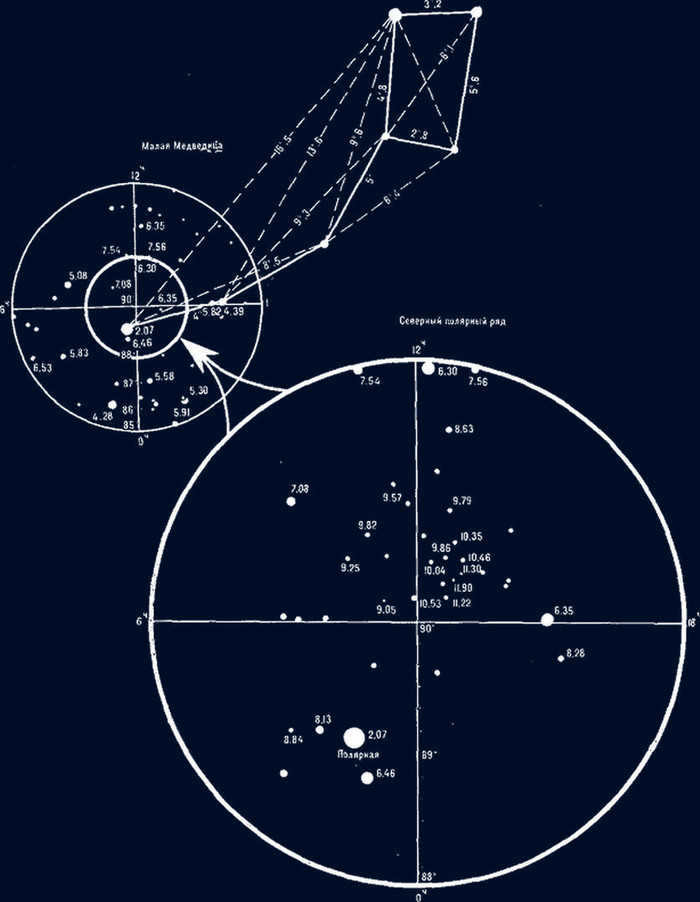
The evolution of Polaris, which is currently taking place before our eyes, is still uncertain in terms of its ultimate outcome.
The distance to Polaris is quite vast. According to various estimations, it ranges from 300 to 500 light years (the latest data suggests 447 light years, and this distance is gradually decreasing). The significant variation in measurements is due to the fact that accurately determining the distance using the parallax method for such distant celestial bodies is not currently feasible. However, regardless of the exact distance, Polaris is significantly farther away than the stars in the Big Dipper, despite appearing equally bright visually. This implies that its actual luminosity is much higher than that of the stars in the Big Dipper.
Stars like this have a short lifespan, and in a few million years, Polar will undergo a supernova explosion. However, before that happens, it has the potential to serve as a guiding star for the people of Earth multiple times.
As a special treat for those who have read the entire article, there is a musical bonus at the end. This piece is dedicated to the nymph Callisto, who was mentioned earlier in the article. It depicts Callisto’s dog, which carries the crucial Polar Star in its tail.
The track “Nymph Callisto” can be found on my album Star Bridge.
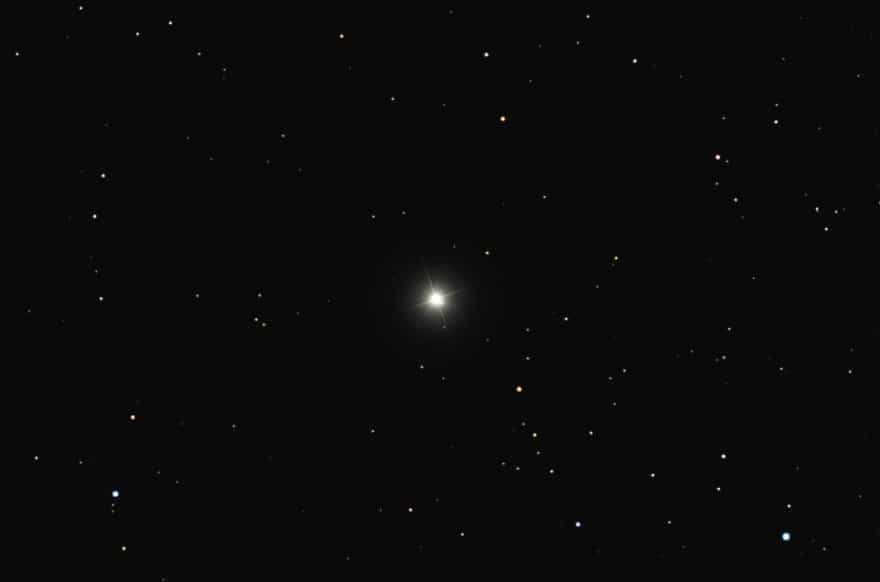
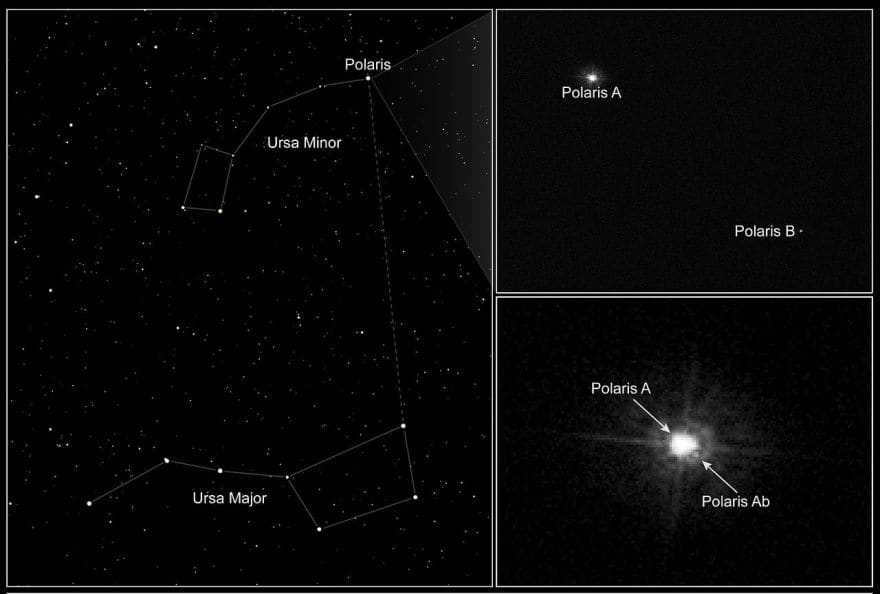
Polaris serves as a guide to the north pole and is situated in the constellation Ursa Minor, specifically in its tail, making it the furthest star. To locate Polaris in the night sky, look for the constellation Ursa Major, also known as the Big Dipper, which is much more prominent and widely recognized.
Understanding how to locate Polaris is always advantageous as it is an essential skill for navigating in unfamiliar terrain. Once you have located Polaris, you can determine the exact direction of north and consequently orient yourself to other points on the compass. In the field of astronomy, Polaris is utilized for calibrating equatorial mounts as it remains fixed in the sky during the Earth’s daily rotation.
Polaris is renowned for its unique position, making it one of the most well-known stars. Teaching your children about Polaris and helping them locate it in the night sky can be a valuable learning experience. While many children may have heard of Polaris, they may not know where to find it, so this information will broaden their knowledge.
Locating Polaris
The easiest way to locate Polaris is by using the Big Dipper. This prominent constellation is easily visible in the northern hemisphere throughout the year. However, it’s important to note that the positions of constellations change over time due to the counterclockwise rotation of the celestial sphere. As a result, the Big Dipper is closer to the horizon during winter, shifts to the east in spring, nearly reaches the zenith in late spring, and begins to descend in the west during summer.
The Little Dipper, despite its resemblance to a dipper, is not as prominent and its stars are not as bright. This is why it is always more convenient to locate the Big Dipper initially.
After locating the Big Dipper, finding Polaris is quite simple – just imagine a line passing through the two outermost stars of the Big Dipper’s bucket and extend it further. Polaris will be approximately five times the distance of this line.
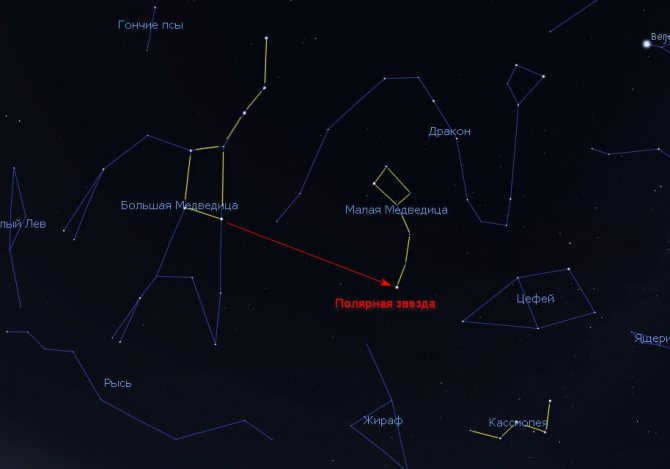
Discovering the location of Polaris in the night sky can be accomplished by utilizing the Big Dipper.
Relatively close by is an additional highly noticeable constellation, Cassiopeia, which resembles a large letter W. Occasionally, due to its intriguing shape, this constellation is the initial celestial formation to capture your attention, subsequently making it effortless to locate the Big Dipper.

Names of Stars
Within the known galaxy, there is no other celestial body that possesses such a multitude of names. Interestingly, the majority of these names are somehow connected to its position in relation to our planet. Polaris, for instance, is situated at the pole, which means that it remains stationary from the perspective of Earth.
Various nationalities have recognized Polaris as a sort of stake that is firmly fixed in the sky, around which all other celestial bodies revolve. It is from this belief that some of the star’s names originate:
These names can be found in ancient writings of Turkic and Finno-Ugric peoples.
In Russia, the name “Polyarnaya” was adopted during the reign of Peter the Great; prior to that, it was known as Severnaya. In the language of the Khakass and Evenks, it is referred to as “Tied Horse” and “Hole in the Sky,” respectively, which adds an original touch to its designation.
According to the information from Wikipedia, the North Star is also known as Kinosura, a term derived from ancient Greek that translates to “tail of the dog,” and Alpha Minor of the Little Bear.
Reasons for the Popularity of Polaris
When you first locate Polaris in the sky, you may feel let down – it appears just like many other stars. Some individuals, however, believe that it possesses a distinct quality – either being brighter or having a different hue. In reality, it is an ordinary star with a magnitude of +1.97m, which places it at the unremarkable 50th position on the list of bright stars.
It has gained its fame for an entirely different reason. Situated near the Earth’s pole, it points almost directly north, with a deviation of less than 1 degree. Polaris has been instrumental in helping people navigate their way across land and sea for centuries, aiding in the plotting of their routes.
Using Polaris for orienteering.
This celestial body not only serves as a reliable indicator of true north, but it also allows for the determination of latitude. By measuring the angle between the observer’s horizon and the altitude of Polaris, one can accurately determine their position on the Earth. Navigators and explorers have been utilizing this method for centuries, making Polaris known as the guiding star – it shows the way and prevents one from becoming lost.
Polaris is positioned in the direction of the Earth’s North Pole.
Due to the Earth’s daily rotation, all the stars complete a full revolution in the sky within a day. However, Polaris remains stationary as it is positioned directly along the north-south axis, which serves as the axis of rotation for the celestial sphere.
This phenomenon can be captured in photographs taken at slow shutter speeds. Each star leaves behind a trail as it moves across the sky, while Polaris remains fixed at the center.
As a result, despite its unremarkable appearance, Polaris holds a special position and carries significant importance. Interestingly, in the southern hemisphere, there are no bright stars in close proximity to the south pole. This means that inhabitants of the northern hemisphere are fortunate to have a reliable celestial landmark.
Assistance for Travelers
The Polaris star, located closest to the North Pole, is frequently utilized by travelers as a reliable navigational aid. On a clear night, this star can be easily observed and remains fixed in its position. Familiarity with locating Polaris in the night sky ensures that one will never stray from their intended course. This traditional method of navigation is actually more precise than even the most modern compasses. This is due to the Earth’s magnetic field constantly fluctuating, causing the compass needle to occasionally deviate from true north. Thus, relying on the surrounding landscape and observing the celestial sphere is a prudent choice.
Over time, the Earth’s polar axis undergoes precession, which means it moves in a circular motion with a radius of 23 degrees and shifts by 1.397 degrees every 100 years. As a result, different stars periodically appear in the direction of the North Pole. Currently, Polaris is the closest star to the pole, but it hasn’t always been and it won’t always be.
Even at present, Polaris is not exactly aligned with the pole – there is a slight deviation, less than one degree, but it is still noticeable. By 2102, this deviation will decrease to only 27 angular minutes, marking the closest position of Polaris to the pole. After that, it will gradually move away from it.
Illustration of the Earth’s axis precession. Image sourced from Wikipedia.
5,000 years ago, the pole star was Alpha Tuban in the Draco constellation. In 12,000 years, the pole star will be Vega, one of the brightest stars in the sky.
Where Can You Find This Celestial Body?
Locating this celestial object is not a challenging task. All you need is a basic understanding of constellations or simply observing closely to identify the most luminous “dot” in the sky. That most luminous dot is none other than the brightest spot in the sky. This celestial body can be found within the “bucket” section of the Big Dipper constellation, completing its handle and aligning with two other prominent stars. Interestingly, it happens to be the nearest star to Earth, positioned at a distance of 450 light years away from our planet.
Understanding Polaris
After mastering the art of locating Polaris in the celestial sphere, you may be curious about the identity and significance of this unpretentious yet highly valuable star. In reality, Polaris is a captivating and extraordinary celestial body. Should you ever journey to its location, you would be astounded by the remarkable phenomena occurring within the Polaris system.
First and foremost, Polaris is located 447 light years away. The light that reaches our eyes from Polaris actually began its journey in the latter half of the 16th century. It’s worth noting that during that time, the Turkish troops were conquering Cyprus, Christopher Columbus had recently discovered America, and the first settlers were starting to colonize the American coast. Just a few years later, Ermak would embark on his conquest of Siberia, Russia was engaged in multiple wars, and France experienced the infamous Massacre of Bartholomew’s Night. So when you observe the light from Polaris, you are witnessing a glimpse of the turbulent times it was born in.
Polaris is a triple system, with its main component being a supergiant star. This star is 2000 times brighter than the Sun, approximately 6.5 times heavier, and 50 times larger in size! It is a relatively young star, estimated to be around 55-65 million years old. This particular star is referred to as Polar A.
Located even further away, at a distance of 2400 astronomical units from the primary star, there exists another celestial object known as Polaris B. With a mass 1.39 times greater than that of the Sun, Polaris B completes an orbit around the Sun within a span of 100,000 years. This intriguing entity can be observed through the lens of an amateur telescope.
However, the peculiarity of Polaris does not end there. The primary component of Polaris, a supergiant star, belongs to a distinct class of variable stars known as cepheids, which are characterized by their pulsating nature. Yet, this particular cepheid stands apart from its counterparts, as its pulsations intermittently subside and then resume. Over the course of several decades, it alternates between periods of brightness and faintness. Remarkably, Polaris represents the closest cepheid to Earth.
Therefore, Polaris is an extraordinarily enigmatic star. Comprised of three physically interconnected stars, each surpassing the Sun in size, one of them being a pulsating supergiant, this celestial system captivates astronomers and researchers alike.
Now, you have gained knowledge not only on how to locate Polaris in the nighttime sky, but also on the nature of this celestial object. Make it a point to locate Polaris and remember all the information you have absorbed about this fascinating entity in space. Additionally, make it a priority to share this knowledge with your children.
A Colossal Celestial Body
Polaris can be observed in great detail using binoculars, and its yellowish hue is easily visible. At first glance, this star may resemble the Sun, but it is distinct from our solar system’s central star. While Polaris is only slightly hotter than the Sun, its luminosity far surpasses that of our Sun. In fact, Polaris is estimated to be over 2,500 times brighter than the Sun. Yes, you read that correctly – 2,500 times brighter! Furthermore, Polaris is more than 30 times larger and over 6 times more massive than our Sun. The colossal size of this star is evidenced by its radius, which is nearly 50 times greater than that of the Earth.
Debunking Myth 5: Polaris Indicates South
Contrary to popular belief, Polaris, which belongs to the Little Bear constellation, actually points north. In the southern hemisphere, the true indicator of the south is its own polar star called Sigma, which belongs to the Octanthus constellation. However, Sigma’s brightness is significantly lower than that of Polaris, making it less commonly used in navigation and less well-known. In fact, even when people mention Polaris, they are usually referring to the North Polarissima, which accurately points north.
By way of explanation
It is generally incorrect to state that a particular star is located in the southern or northern direction. South and north are orientations that are only applicable on planet Earth. Celestial bodies exist outside of Earth, at great distances, and therefore it would be erroneous to claim that Polaris, for instance, is situated in the south. It is akin to a beetle trying to determine the beach’s position relative to a tree.
Interesting fact: The renowned star Polaris indicates the north. In the southern hemisphere, there is a star known as Polarisissima, which points to the south. However, it is much less commonly referred to as South Polaris.
Stars in the Ursa Minor Constellation
The Ursa Minor constellation is composed of a group of seven stars:
- α – Polaris.
- δ – Yildun
- ε – Urodelus.
- ζ – Alifa al Farqadin.
- η – Anwar or Allaso
- β – Kohab
- γ – Ferkad
Illustration of the Ursa Minor constellation. Source: Wikipedia.
The outermost stars, Kohab and Ferkad, are also known as the Guardians of the Pole. Some of the stars in the constellation are quite intriguing, so let’s examine them all in order.
Polaris: The Leader of the Little Bear Constellation
When we gaze up at the night sky, Polaris may seem like an ordinary, unassuming star with a modest brightness of 1.97 meters. In reality, however, this celestial body holds a captivating secret that sets it apart from the rest.
Located in close proximity to the Earth’s North Pole, Polaris stands out among the countless stars that dot the night sky. Its significance lies not only in its position, but also in its fascinating nature.
Despite its unassuming appearance, Polaris is actually a triple star system. At a distance of approximately 447 light years away, exploring this cosmic wonder would be an awe-inspiring journey.
Even from our vantage point on Earth, we can observe the duality of Polaris through a telescope. At the heart of this intricate system resides a supergiant star that surpasses our own Sun in size by fiftyfold, weight by 6.5 times, and brightness by a staggering 2000 times.
This star was initially discovered by William Herschel in 1779. Although it has a yellowish-white appearance, when observed through a telescope, it appears to have a greenish hue due to an optical illusion. So, take a moment to observe this stunning pair – it is truly captivating.
The third component of this system is located very close to the central supergiant. This particular star has a mass that is 1.26 times that of the Sun and completes one revolution every 30 years. It is identified as Polaris B.
However, Polaris possesses another intriguing characteristic – it is a variable star of the Cepheus delta type, specifically a Cepheid. Furthermore, it is the closest known Cepheid to us. As a reminder, Cepheids are pulsating stars that exhibit strict periodic increases and decreases, resulting in fluctuations in their brightness. Yet, Polaris is an exceptional Cepheid because its pulsations are diminishing. Even a century ago, its brightness varied significantly more than it does now, but it has since become noticeably brighter.
Polaris is famous for its proximity to the North Pole. However, it has not always been the polar star and it will not always be in the future. Due to the Earth’s axis precession, different stars will take its place as the closest to the pole. Therefore, in 2102, Polaris will no longer hold this position and will be replaced by another star. By the year 3200, the star Cepheus gamma will take over as the closest to the pole, and in 13000, it will be Vega, the alpha star of Lyra. Interestingly, Vega already held the position of the polar star back in 13000 BC.
Yildun Represents the Delta of the Little Bear Constellation
Yildun is a youthful star, with an age of approximately 170 million years. Its high temperature of 9900 K classifies it as a white dwarf, despite having a radius 2.8 times larger than that of the Sun. Unlike Polaris, Yildun is located in close proximity to us, at a distance of 172 light years.
Due to its rapid rotation, Yildun is expected to exhibit noticeable flattening at its poles. In approximately 700 million years, this star will transform into a red giant – a fate shared by our Sun, albeit much later. As Yildun draws nearer to us, it will gradually increase in brightness.
Urodelus represents the epsilon star in the constellation of Ursa Minor.
This celestial body is actually a binary star system. At its core, there is an orange giant star, which is 19 times bigger than our Sun and three times more massive. Despite having a similar temperature to the Sun, the orange giant emits 225 times more light due to its significantly larger surface area.
The second star in this system has not been extensively studied. It is identified as a white dwarf star that follows an orbit around the primary star, completing one revolution in just 39.5 days. This close proximity between the two stars causes variations in the system’s brightness, as the smaller star intermittently eclipses the larger one. As a result, Urodelus is categorized as an Algol-type variable star.
The distance to this binary star system is approximately 300 light-years, and it is gradually moving closer to our solar system at a rate of 10.5 km per second.
Alifa is the brightest star in the constellation of Ursa Minor.
Alifa, also known as Zeta Ursae Minoris, is a hot white star with a surface temperature of approximately 9000 K. It is six times larger than our Sun and emits 191 times more light. Alifa is located at a distance of 337 light years from Earth, making it appear as a faint star with a magnitude of 4.2m in the night sky.
Allaso is one of the stars in the Little Bear constellation
This particular star is also known by its popular name – Anwar al Farkadin. In the night sky, it may appear ordinary with a brightness rating of 4.95m. However, it is actually located about 96 light years away from us.
Upon closer observation, we would discover that Allaso is actually a binary system. The primary star in this system is a white-yellow dwarf, which is nearly twice the size of our Sun, 1.66 times more massive, and slightly hotter. This is the star that we can see in the sky.
The secondary component of Allaso is not well understood. It is classified as a red dwarf and is located 13 light years away from the main star. Although this may seem like a significant distance, gravitational interaction is still possible between the two stars.
The orange giant in the constellation is the second brightest star, measuring 42 times the size of the Sun and 2.5 times its weight. Kohab emits 400 times more light than our Sun, and if it were positioned at the center of our solar system, its massive radiation would obliterate everything in its path.
Kohab has a satellite that is yellow-orange in color and has a brightness rating of 11.3. This satellite can be detected at an angular distance of 3.4 seconds.
In 2014, astronomers discovered an exoplanet in Kohab that is six times more massive than Jupiter. This planet’s maximum distance from the star is only 1.4 astronomical units (a.u.), and it completes a full orbit around the star in just 522 days. Given the size and power of Kohab, this exoplanet can be classified as a hot Jupiter.
Ferkad is the gamma of the Little Dipper
This particular star is not particularly noteworthy – it is a typical white giant, with a size 15 times that of the Sun and a mass 8 times greater. Ferkad emits 1100 times more light than the Sun, making it appear as bright as +3m in the sky, despite the considerable distance of approximately 480 light years that separates us.
Ferkad is classified as a variable star of the Delta Shield variety, meaning that its brightness fluctuates by 0.05m over a period of 3.43 hours. These variations are caused by disturbances on the star’s surface.
A few intriguing facts about this enigmatic celestial body
Let’s take a moment to ponder over the concise, yet no less captivating characteristics of Polaris:
- According to scientists, this mysterious luminary was once adorned with a captivating light blue hue. A captivating light blue hue..
- In the past, there were other stars that held the title of being closest to the Peace Pole, so it wouldn’t be surprising if Polaris loses its status in a couple of centuries. This is due to the Earth’s axis constantly moving in a circular motion.
- The age of this celestial body is estimated to be around 80 million years.
- The surface temperature of Polaris is approximately 7,000 degrees, making it slightly hotter than the sun.
- Polaris is not the most luminous celestial body in the galaxy. It is ranked as the 46th brightest celestial body, out of all the celestial bodies in the galaxy. It holds the 46th position.
- The minimum pulsation of this celestial body was observed in 1999. Since then, there has been a significant increase in this measurement.
- Scientists are still unable to provide explanations for the multitude of mysteries surrounding this celestial body.
- According to legend, when souls depart from the mortal realm, they ascend to a heavenly abode situated just beneath this celestial entity. As the gates of the palace open, an extraordinary phenomenon known as the Northern Lights is unleashed. The Northern Lights phenomenon.
- Sometimes, instead of one Polaris, two stars appear in the sky. and they’re equidistant from the North Pole and equally bright.
- Polaris alters its pulsation approximately every 4 days.
- Polaris was referenced in the writings of numerous poets and writers, including Nikolai Karamzin, Semyon Bobrov, and Ivan Bunin.
Polaris is situated in the constellation of Ursa Minor, but due to the dimness of other stars in this constellation, particularly in urban areas, only Polaris itself is visible, and none of the other stars in this constellation can be seen. However, nearby is the prominent and easily recognizable constellation of Ursa Major, which contains multiple bright stars. As a result, many people mistakenly associate Polaris with Ursa Major, without delving into the specifics. In reality, this is incorrect: Polaris is the brightest star (alpha) in the constellation of Ursa Minor.
Fact: Polaris is located in the constellation of Ursa Minor, and the Big Dipper is simply used to locate it.
Debunking Myth 1: Polaris and Venus are not interchangeable
One common misconception is that Polaris and Venus are the same celestial object. This belief may stem from the fact that Venus often appears larger and brighter than other stars and planets in the night sky. However, this is not accurate. Polaris, also known as the North Star, is a bright star located near the north celestial pole, while Venus is a planet that orbits the Sun. Though both Polaris and Venus can be seen from Earth, they are distinct entities with different characteristics.
Indeed, Polaris and Venus are distinct entities in the cosmos. Venus is an orbiting planet within our solar system, slightly smaller in size compared to Earth. On the other hand, Polaris shines as a star, surpassing our Sun’s radius by 30 times. The average distance from Earth to Venus is approximately 37.5 million times shorter than the distance to Polaris (although this can vary due to the planets’ orbital movements, with a minimum difference of 15 million times). It is crucial to note that these two luminaries occupy different positions in the sky and can be easily observed. By familiarizing oneself with the whereabouts of Polaris and the specific location of Venus at a particular time and place, one can witness the individuality of these celestial bodies.
The phenomenon that can be observed in the western part of Russia during winter is the simultaneous visibility of both Venus and Kinosura above the horizon.
As a side note
Occasionally, another misconception arises in a different form: Polaris is mistaken for a planet. However, this is a myth as well. Polaris is, in fact, a star. Furthermore, modern research has revealed that it is a triple star system, which has even been captured in photographs using powerful telescopes. Therefore, it is entirely incorrect to refer to it as a planet.
An image of Polaris through a telescope reveals two companion stars, which appear as one to the naked eye.
Fact: Polaris and Venus are distinct celestial objects and should not be confused.
Now, while on the topic of brightness, let us address another common myth…..
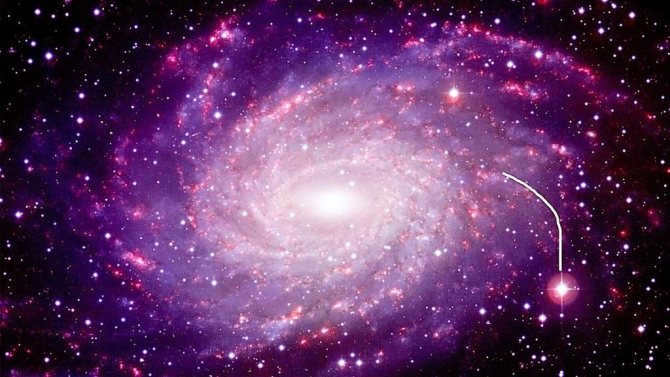
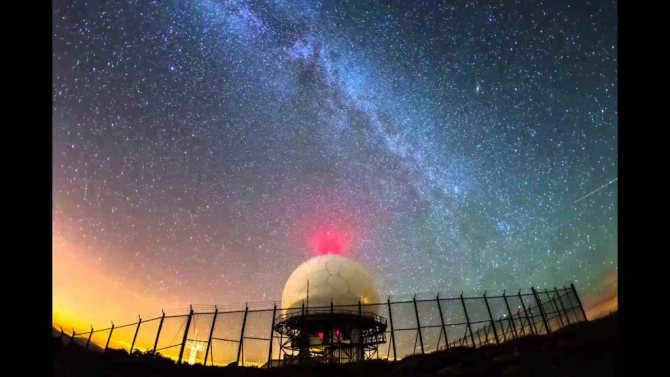


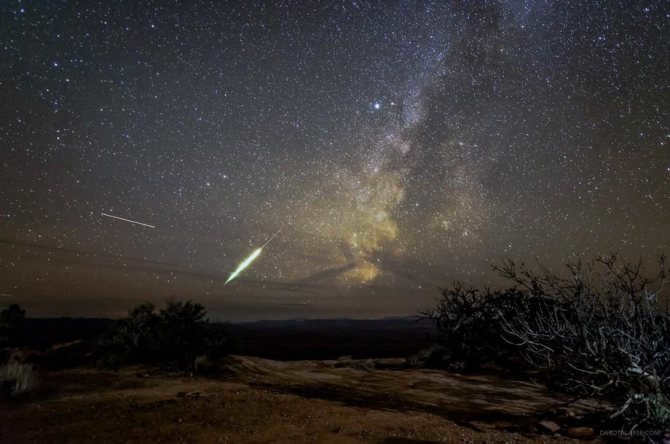
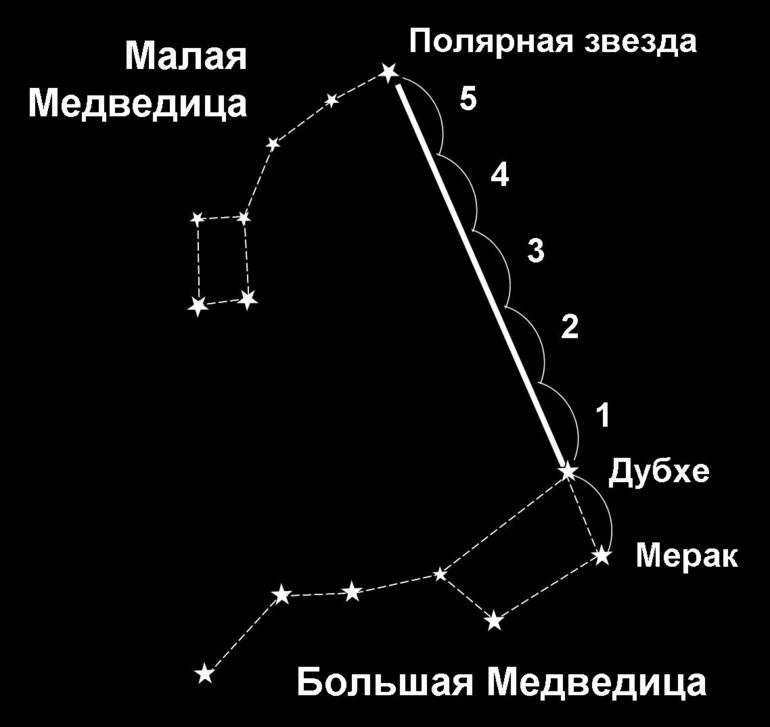
Polaris, also known as Alpha Minor (α UMi) or Kinosura, is a bright star with a magnitude of +2.0m. It is situated in the constellation of the Little Bear, close to the North Pole of our planet. Polaris is classified as a supergiant and belongs to the spectral class F7Ib. Astronomers estimate its distance from Earth to be around 434 light-years, although there are conflicting reports suggesting it may be 323 light-years away. However, these alternative measurements are not widely accepted among experts.
Title
Polaris, also known as the North Star, is a celestial body that holds many different names due to its unique characteristics. One of its most notable features is its position at the pole, which gives it a sense of immobility and stability.
Throughout history, various cultures have come up with different names to describe Polaris. Some believed that it was like a stake driven into the sky, serving as a central point around which all other stars revolve. This belief is reflected in names such as Heavenly Stake, Prikol-star, Iron Stake, and Northern Nail, which can be found in languages like Turkic and Finno-Ugric.
In Russia, the name Polarnaya was introduced during the reign of Peter the Great, borrowed from the German language. Before that, the North Star was referred to as Severnaya, which also conveyed the same meaning. The Khakasses had a more poetic name for Polaris – the Bound Horse, emphasizing its immobility. Similarly, the Evenks saw Polaris as a Hole in the sky, symbolizing its unique position in the celestial sphere.
Also, check out: Knife sharpening methods: machines and sharpeners, DIY sharpening tools, step-by-step system, correct sharpening angles
Unrelated names to its location are rare for Polaris. One of the most well-known of these names is Kynosoura, derived from the Greek word Κυνόσουρα, meaning “tail of the dog.” The ancient Greeks and Romans referred to Polaris as Kynosoura, but during that time, Polaris did not yet serve as the true North Star (2000 years ago, the star Kochab or β of the Little Bear was closer to the North Pole).
Interestingly, on ancient maps, Polaris does indeed indicate a tail, but not a dog’s tail, rather a long, non-existent tail of the Little Bear.
An intriguing theory exists regarding the etymology of Kinosura. According to Allen and other star name scholars, this was the ancient designation for the entire constellation of Ursa Minor, also known as the Little Bear. In a variant of the myth surrounding the birth of Zeus, the infant deity was nurtured in a cave by two bears – Helica (or Helis) and Kinosura – who were subsequently elevated to the heavens as a gesture of gratitude from Zeus. Helica became the prominent asterism known as the Big Dipper, while Kinosura came to be associated with the Little Dipper. Over time, however, the name Kinosura came to exclusively refer to Polaris. This legend begs one question: how did the bear come to possess such an unusual name?
Overview
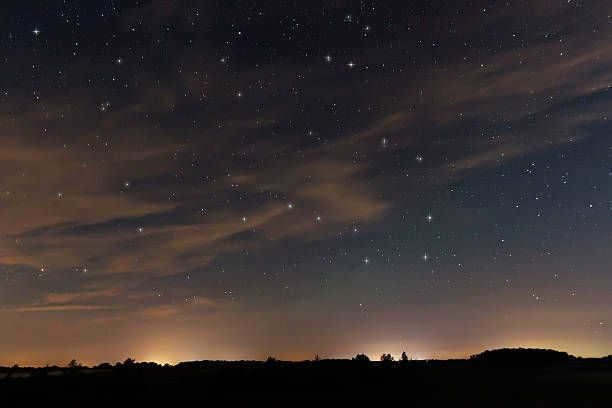
Polaris, the main star in the constellation of the Little Bear, is larger than the Sun. It consists of three main components: α Umi Aa, α Umi B, and α Umi Ab. Additionally, there are two distant components, α Umi C and α Umi D. The discovery of α Umi B dates back to 1780 when it was observed by the renowned astronomer William Herschel. The Little Bear constellation, which Polaris is a part of, is highly popular among enthusiasts of astronomy. This constellation, along with other notable asterisms such as the Big Dipper, Orion’s belt, and Cassiopeia, is considered to be one of the most prominent in the night sky.
The constellation known as Ursa Minor is highly popular among children, not only due to its educational value regarding the night sky, but also because of the fascinating Greek mythology legends associated with it. Thus, the majority of children are aware of the answer to the question of which constellation Polaris is located in. Additionally, for observers in the Northern hemisphere, Polaris can be seen almost directly overhead during the winter season. At the North Pole, it is visible at the zenith. However, when viewed through a telescope, Polaris does not display the same stunning beauty as other stars, and it lacks the presence of beautiful nebulae and galaxies in its vicinity. Nevertheless, on the star map, it consistently serves as a reliable reference point for navigation.
The precise measurement of Earth’s distance
In the previous discussion, we have already covered the significance of Cepheids in the field of astronomy. With their pulsation periods closely linked to luminosity, these celestial objects serve as beacons of the cosmos, enabling scientists to calculate distances to galaxies beyond our own.
Back in the late 1920s, the American astronomer Edwin Hubble made a groundbreaking discovery while observing the Cepheids in the Andromeda Nebula. This discovery allowed him to determine the distance to the Andromeda Nebula and, in turn, prove the existence of other galaxies. It also enabled him to construct the first-ever scale of distances in the Universe. Even today, the Cepheid method remains widely used and forms the basis of our knowledge regarding the scale of the Universe, the size of other galaxies, and the distances to them.
However, there is a slight issue. As mentioned earlier, Cepheids are rather uncommon celestial objects. Therefore, it comes as no surprise that there are no such stars in close proximity to our Sun. The nearest Cepheid, Polaris, is also quite far away, with an estimated distance of around 400 light-years.
From this distance, the error in parallaxes is significant. The parallax of Polaris, determined by the satellite Hipparcos (HIPPARCOS), is the most accurate to date, with an error of 8 light years or approximately 2%. It is even more pronounced when considering the more distant Cepheids!
Amidst this backdrop, astronomer David Turner recently published a groundbreaking study revealing that the current distance to Polaris may be overestimated by as much as 111 light years compared to the measurements obtained from the Hipparcos satellite! To conduct his research, Turner utilized the impressive BTA telescope, boasting a mirror diameter of 6 meters, making it the largest telescope in Russia. Turner’s team, comprising of esteemed Russian astronomers, meticulously analyzed Polaris’s spectrum and made an astonishing discovery – the star emits considerably fainter light than previously believed, based on parallax measurements. Consequently, one can’t help but wonder if the Hipparcos satellite erroneously gauged the distance to Polaris. Moreover, this revelation begs the question – what about the approximately 120,000 other stars that underwent measurement?
The HIPPARCOS data, currently overseen by astronomer Floor van Leeuwen from the Netherlands, was promptly defended in a response paper. Van Leeuwen successfully demonstrated the accuracy of the satellite data, in contrast to Turner’s data. The ensuing debate quickly gained traction on the Internet, attracting attention from various media outlets. This highlights that the debate is not solely academic, but also encompasses differing worldviews.
Indeed, accepting the new distance to Polaris would necessitate acknowledging a significant overestimation of the true scale of the Universe. This raises further questions about the prevailing theory regarding the rate of expansion of the Universe. Notably, the Nobel Prize for discoveries in this field was already awarded in 2011!
The organization of the Polaris star system
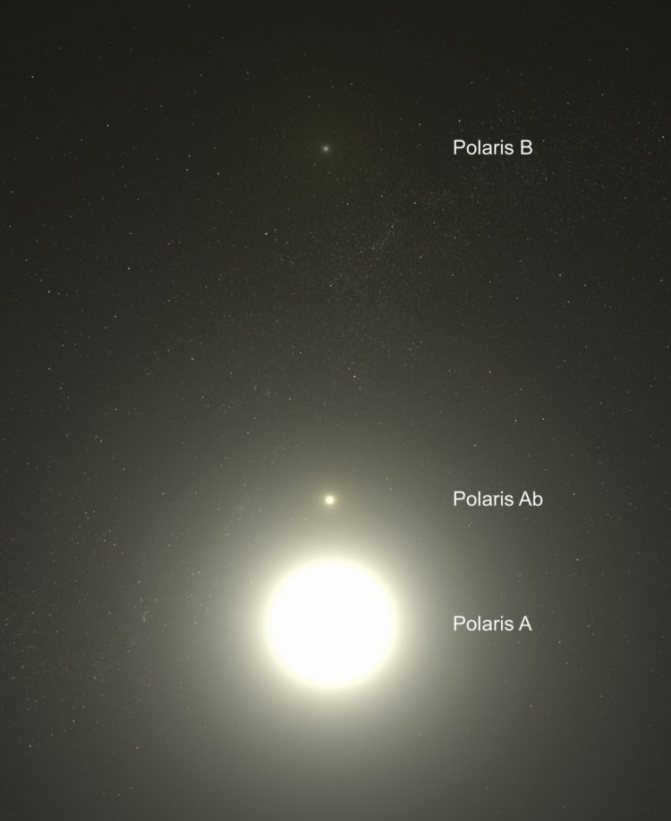
Polaris, also known as α UMi Aa, is a star that is 4.5 times larger than the Sun in terms of mass. It belongs to the spectral class F7, which classifies it as a supergiant (Ib). Interestingly, it is the first classical Cepheid that has had its mass directly measured due to the presence of satellites.
There are two smaller companions to Polaris. The first is α Umi B, which has a mass of 1.39 solar masses and belongs to the spectral class F3. It is located 2400 AU away from Polaris. The second companion is α Umi Ab, which is a very close F6 main-sequence star with an orbital radius of 18.8 AU and a mass of 1.26 solar masses. In addition to these companions, there are two more distant components, α Umi C and α Umi D, but they are not physically associated with Polaris.
Polar B (α UMi B) is visible even with a small telescope. It was first observed by William Herschel in 1780 using one of the most advanced telescopes of the time, a reflector telescope that he built himself. In 1929, it was discovered through spectral analysis that Polaris A is actually a very close binary system, with a faint companion star (α Umi Ab). In January 2006, NASA released Hubble Telescope images that clearly showed all three members of this triple system. The closest star to Polaris is located at a distance of 18.5 astronomical units (2.8 billion kilometers), which explains why we only became aware of the presence of the smaller companion in 2006.
Contemporary approaches
Utilizing state-of-the-art technology, the task is simplified. These devices possess the capability to indicate the precise position of the target point. Additionally, the process does not necessitate an extensive amount of expertise.
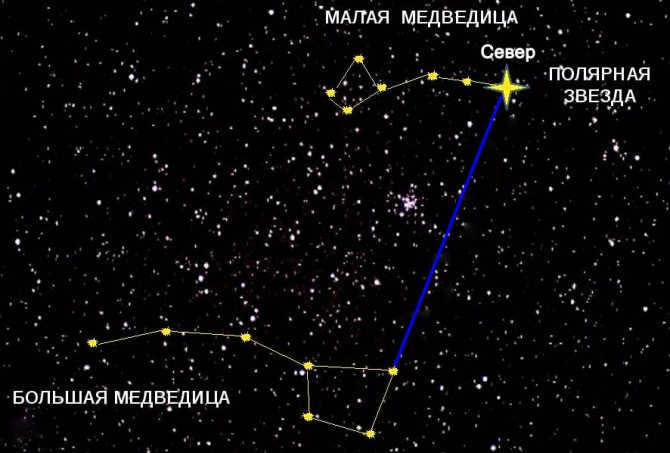
The telescope is the most optimal choice. It allows for inputting basic parameters and provides the desired outcome.
However, this equipment can be quite expensive and not readily available to everyone. An alternative option is to use a SLR camera.
The operational principle is as follows:
- On a clear weather day, set up the device on a tripod and aim it towards the sky.
- Capture a photo over a span of 2 hours, ensuring sufficient battery life.
- The resulting image will display distinct star movements, while one star remains stationary. This star is Polaris.
If you are using a smartphone as your equipment, you will need a special program. After that, you can point your device towards the beautiful starry sky. Once the constellation images start appearing on your display, direct your camera towards the Big Dipper and Little Dipper. You will find Polaris at the edge of the minor constellation.
Overview
When it comes to its physical characteristics, this supergiant star is quite ordinary. Even in a small telescope or binoculars, the star displays a yellowish color, which may surprise some people who are accustomed to thinking of it as white. In reality, it is only slightly hotter than our Sun, with a surface temperature of around 6000 K. However, the similarities end there.
Similar to many other stars visible to the naked eye in the sky, Polaris is more luminous than the Sun when observed from the same distance. Analysis of its spectral characteristics has revealed that it falls into the category of supergiants. With a diameter 23 times larger than our Sun and a luminosity 2500 times greater, Polaris surpasses even Sirius in these aspects.
Nevertheless, there is a complication as astronomers encounter difficulty in accurately determining the distance to this prominent star in the constellation Ursa Minor. Consequently, estimations of its brightness and temperature can differ.
Ancient tales
There are numerous legends and superstitions that have been passed down to us from ancient times. According to Arab tribes, they believed that the shining dot in the sky was nothing more than a resting place for a celestial warrior, resembling a coffin. On the other hand, the Indians had a different interpretation, stating that it represented a young boy who offered prayers to the gods and remained oblivious to everything else. It is worth noting that these peculiar and beautiful names for celestial bodies were given by the ancient inhabitants of our planet. Even in those times, people possessed the knowledge of locating Polaris in the sky with the help of the Big Dipper.
Compared to the Sun, it is relatively short and appears after the hydrogen in its core is depleted. Supergiants are typically old and highly evolved celestial bodies. This doesn’t mean they are old in terms of age, but rather that their life cycle is nearing its end, unlike the Sun.
Today, we can speculate that Polaris, located in the Milky Way galaxy, was once a bright blue star of spectral class Β. It had a mass approximately 5 times that of the Sun and a radius 3.5 times larger. Its surface temperature was around 18,000 K, three times hotter than the Sun. However, these physical characteristics have since changed (as mentioned above).
A star that changes in brightness

Polaris is a supergiant star that consists primarily of a classical variable known as a Cepheid. Due to the significance of cepheids in measuring distance, extensive research and analysis have been conducted on the Little Bear’s akmaf, which is the closest cepheid. Astronomers from multiple generations have extensively studied and analyzed the variability of this star, with suspicions dating back to 1852 and confirmation by Einar Hertzsprung in 1911.
Before searching for Polaris, it is important to familiarize yourself with its key characteristics. This will not only assist in locating it more quickly in the night sky, where there are no labels indicating the names of stars and constellation boundaries, but also prevent common errors. Additionally, there are several misconceptions regarding Polaris.
Therefore, people tend to be mistaken about the following:
- Polaris is positioned directly above the North Pole on the celestial sphere, making it appear at the zenith. However, this does not mean that it is directly overhead. If it were, it would not be able to point to the north. The name Polaris comes from its location, as it is situated exactly above the North Pole of the Earth. It can only be seen in the middle of the sky from this point. As you move farther away from the pole, Polaris descends lower towards the horizon until it eventually disappears from view at the equator. Due to this, Polaris cannot be used as a reference point in the southern half of the planet. In that region, the direction is determined by the constellation Southern Cross.
Did you know that Polaris is more accurate than a compass for determining the north? While a compass points to the northern magnetic pole, which shifts every year, Polaris remains fixed above the North Pole of the planet. This makes Polaris the most reliable tool for determining coordinates, especially closer to the north.
- It’s a common misconception that Polaris is the brightest star in the sky. In reality, it doesn’t even rank in the top ten brightest stars, coming in at a modest 48th place. So, if you’re lost and relying on brightness alone, you’re more likely to find stars like Sirius or Vega instead of Polaris. Remember, using Polaris as a navigational guide could be a matter of life or death.
However, this will not be the case for long. The Earth’s axis is constantly in motion, gradually shifting over time. On a cosmic scale, it completes a full revolution approximately every 25,800 years. As a result, Polaris, the current North Star, has not always held this position and will not remain there indefinitely. In approximately 13,000 years, the bright star Vega will take its place, making it easier for future generations to navigate and locate the North Pole.
- Polaris stands alone as the unique one. Actually, Polaris has not always been known for its constancy, especially when compared to the standards of centuries. The truth is that Polaris has not always been known as Polaris. Similar to how the Earth’s gravitational force affects the movement of a spinning wolf, the gravitational forces of the Sun and Moon also impact the spinning Earth. As a result, the Earth’s axis, like that of a wolf, shifts its position in space and undergoes precession, causing its projection on the celestial sphere to trace circles.
Over time, the position of the North Pole of the world gradually changes. However, at present, Polaris is getting closer to the pole and on March 24, 2100, it will be closer than ever before – they will only be separated by 27 angular minutes, which is less than the visible diameter of the Moon. Since the Earth’s precession period is 25800 years, different stars have served as the pole star at different times. For instance, in 2600 BC, when the ancient Egyptians were still constructing the pyramids, the star Tuban from the Draco constellation was the pole star. The brightest of the guardians, Cohabus, was the pole star during Plato’s time 2600 years ago. By 14000 A.D., the Earth’s axis will be pointing towards Vega, one of the most brilliant stars in the sky, so future generations will not mistake it for Polaris, the brightest star.
Using a Map and Compass
There is no need to resort to drawing lines in the sky in order to locate a particular celestial body. Instead, you can utilize a large-scale map or an area map. The key is to have the map properly labeled with significant landmarks. Here is the step-by-step process:
- Locate your position on the map.
- Select a prominent distant object, such as a large building or road.
- Orient the map in a way that aligns your position and the chosen object on the same line.
- Always remember that the top center of the map represents north. Direct your gaze towards this point and then shift your focus upwards.
- On the vertical line, you will find Polaris. The star’s altitude at this position depends on the latitude of the terrain and the time of year. This specific information can be obtained from reference literature.
Having a compass makes it much easier to determine the position of Polaris. The key is knowing how to use the instrument. As you are aware, its needle always points north. Once that is established, you must account for magnetic declination.
For instance, if the declination is 15° to the west, you must adjust the compass by the same number of degrees to the left.
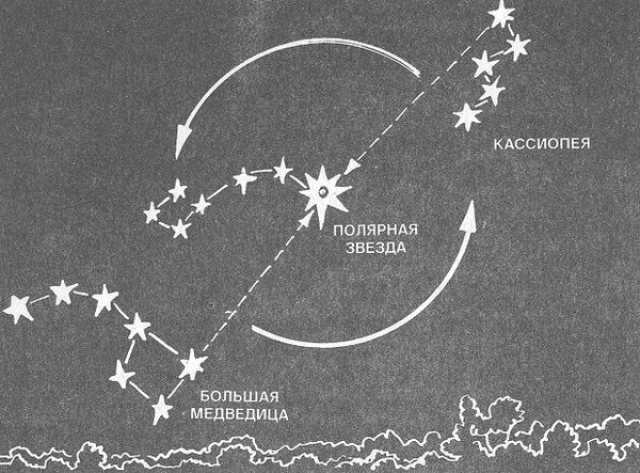
How can you navigate using Polaris? The first step is to learn how to locate it in the sky. The simplest method is to start with the Big Dipper – a well-known constellation. Take the two stars on the outer edge of the dipper (known as Dubhe and Merak) and mentally draw a straight line through them. Polaris can be found at a distance five times greater than the distance between Merak and Dubhe. This star has a yellowish-white color and is about as bright as these two stars.
Once you have identified Polaris, you can draw a line perpendicular to the horizon from it. The point where this line intersects the horizon will indicate the north direction, and it will be more accurate than using a compass! Finding the other cardinal directions becomes easy: south is in the opposite direction, east is to the right, and west is to the left of Polaris.
One more fascinating and significant characteristic of Polaris is its elevation above the horizon. We have previously mentioned that because it is close to the Earth’s pole, Polaris remains virtually stationary for a particular location. However, the star’s height above the horizon can vary depending on the geographical position! Therefore, if we were at the North Pole, we would observe Polaris directly overhead, while at the equator (on the Earth’s “side”), Polaris would be almost exactly at the horizon. As a result, the elevation of Polaris above the horizon determines the latitude of our position. In the past, sailors were able to determine how far north or south they had traveled by measuring the angle between Polaris and the northern horizon each night.
The Southern Cross: an Iconic Landmark in the Southern Hemisphere
Residents of the southern hemisphere have a distinct celestial reference point. This reference point comes in the form of a constellation known as the Southern Cross, which unfortunately cannot be observed in latitudes outside of this region. The Southern Cross consists of four stars arranged in a cross-like pattern. In close proximity to this constellation, there is another similar formation called the False Cross. However, the False Cross differs from the Southern Cross in terms of the wider spacing between its stars.
To orient yourself towards the southern direction, follow the stars that form the vertical “crossbar” of the Southern Cross and mentally trace a line along them. To minimize any potential errors, it is advisable to wait until the constellation is perfectly aligned in a vertical position in the sky. At this point, it will be perpendicular to the horizon, with the south lying directly beneath the Southern Cross.
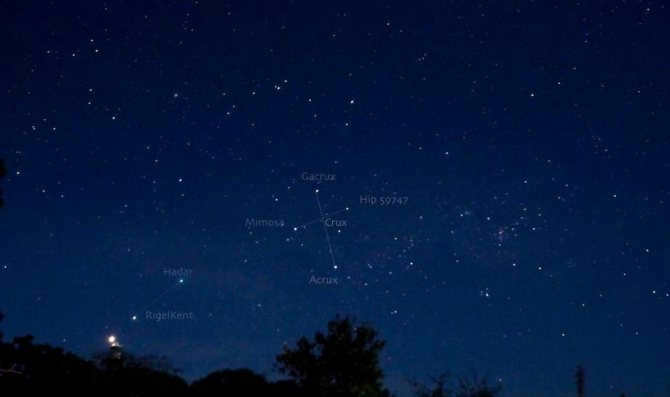
What is the method to locate Polaris?
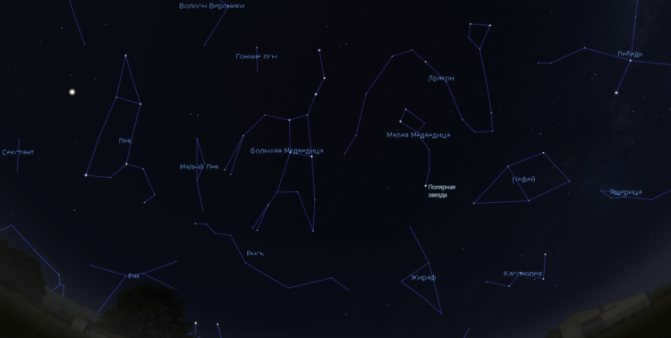
Stella Polaris, also known as Polaris, can be found in the Ursa Minor constellation, commonly referred to as the Little Bear. The Little Bucket is another name often used for the seven stars of the Dipper. Polaris is located on the “handle” of the Little Bucket. It is surrounded by faint stars, with the four dimmest only visible on a moonless night with minimal street lighting.
To locate Polaris, you can look at the stars Dubhe and Merak in the Big Dipper constellation. Mentally connect these stars with a line, and extend the line five times – Polaris will be somewhere in the vicinity.
By utilizing technological tools,
However, there are instances in which locating constellations becomes challenging: the presence of trees obstructs a portion of the sky, clouds are dispersed unevenly, or the stars fail to form recognizable patterns due to lack of experience. In such cases, technological devices prove to be invaluable aids in the quest for Polaris.
If you happen to have a camera with you – preferably the trendy “SLR” – then capturing Polaris is within your reach. I’m sure many of you have come across those stunning photos of the night sky, taken with a slow shutter speed, where the moving stars leave behind luminous trails. The length of these trails indicates the distance traveled by each star. Being situated at the axis of the celestial sphere and maintaining minimal movement, Polaris creates a unique pattern – concentric circles formed by the tracks of all the stars, with the smallest and shortest circle representing the track of Polaris itself.
There are, naturally, its subtleties. Thus, on the camera you must manually open the aperture to its maximum, adjust the focus to infinity, and set the appropriate light sensitivity within ISO 400-600 – otherwise, the image will be heavily backlit. The shutter speed at this sensitivity should be adjusted to half an hour: typically, this is sufficient to clearly see the tracks. Since this will occur at night, it is important to consider the potential for condensation to form on the lens. The simplest way to avoid this is to remove the camera from the bag, place it on a cold, dry surface, and allow it to “breathe” for a couple of minutes. This will cause it to cool down and allow any condensation to dissipate before taking a photo. Additionally, it is crucial to secure the camera, as any movement of the camera will negate the time spent. However, for precise results, it is worth experimenting with your camera to determine the exact settings. For instance, you may require a special remote control to adjust the shutter speed to a slow setting not offered by the manufacturer.
If you don’t possess an appropriate camera, you can utilize dedicated mobile applications. For Android, there is the Stellarium app and for iOS, there is Sky Guide. Additionally, there are numerous similar apps available. These apps can assist you in recognizing constellations in the sky by utilizing your smartphone’s camera, or they can calculate the precise position of constellations based on your selected location, season, and time of day. This feature is highly advantageous, as these programs can enhance the capabilities of your camera, even though it may be technically incapable of capturing the stars.
Utilizing alternative star constellations
Identifying the position of Polaris using the Big Dipper is not always feasible. The Big Dipper is a vast constellation, and some of its stars may be obstructed by clouds, making them invisible. In such circumstances, other star clusters in the night sky can be employed. These constellations include:
- Cassiopeia. The midpoint of this constellation, known as Rukbach, is connected to the second-to-last star of the Big Dipper’s handle. The midpoint of the resulting line segment can then be mentally located, which will correspond to Polaris.
- Cygnus (The Swan). Two stars in this constellation, namely Jenach and Deneb, are sought after. A line is drawn through these stars, and a point equal to twice the distance between them is marked on this line. Polaris will be found nearby in this vicinity.
- Orion. A visual line can be traced from the central star Alnilam through Meissa in this constellation. This particular line is mentally noted. The line is then extended further to the planet Capella in the Ascendant constellation. The magnitude of the Alnilam – Meissa section is marked on it. Polaris can be found at the end of this line.
Determining the position of Polaris using these three methods can be quite challenging, so some level of skill will be necessary.
Polaris (), known as α Ursae Minoris (also called Alpha of the Little Bear or abbreviated Alpha UMi, α UMi), is the most luminous star in the constellation of the Little Bear. It is situated in close proximity to the Earth’s northern pole, which makes it the current northern polar star. The revised Hipparcos parallax measurement indicates that Polaris is located at a distance of approximately 433 light-years (133 parsecs), although calculations based on alternative methods suggest distances that are about 30% closer.
Polaris is classified as a triple star system, consisting of a primary star named Polaris Aa (a yellow supergiant), which is in orbit with a smaller companion (Polaris Ab). Additionally, there is another pair of stars in orbit with Polaris B, which was discovered by William Herschel in August 1779.
The stellar system
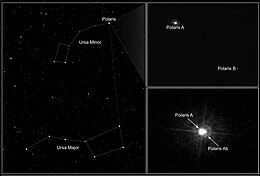
Using the Hubble Space Telescope, we can observe various components of Polaris.
Polaris Aa, a yellow supergiant of spectral class Ib, has a mass similar to that of the Sun, specifically 5.4 M ☉. It is also the first classical Cepheid star whose mass has been determined based on its orbit. Polaris B, on the other hand, is a main-sequence star of the F3 type with a mass of 1.39 M ☉. It orbits at a distance of 2400 astronomical units (AU). Lastly, we have Polaris Ab (also known as P), a very close main-sequence star of the F6 type with a mass of 1.26 M ☉.
Polaris B is visible through a modest telescope. In August 1779, William Herschel made the discovery of this star using his own reflector telescope, which was one of the top telescopes at that time. By studying the spectrum of Polaris A, it was found in 1929 that it is actually a very close binary system with a secondary dwarf (also known as α UMi P, α UMi an or α UMi Ab), which had been suggested in earlier observations (Moore, J. H. and Cholodowski, E. A.). In January 2006, NASA released Hubble Telescope images that revealed the three members of the Polaris triple system.
At one point, it was believed that there were two other distant components – Polaris C and Polaris D – but it has since been determined that they are not physically related to the Polaris system.
Observation
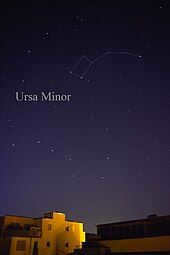 Polaris, located in the top right of the constellation of the Little Bear, is the most luminous star in the area.
Polaris, located in the top right of the constellation of the Little Bear, is the most luminous star in the area. 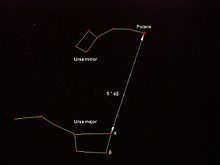 When considering the Big Dipper and Little Dipper, Polaris serves as a point of reference.
When considering the Big Dipper and Little Dipper, Polaris serves as a point of reference. 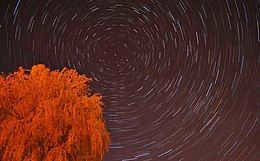 In a typical star trail in the Northern Hemisphere, Polaris is positioned at the center. When observed through a small telescope, Polaris B is found to be 18 angular seconds away from the main star, Polaris A.
In a typical star trail in the Northern Hemisphere, Polaris is positioned at the center. When observed through a small telescope, Polaris B is found to be 18 angular seconds away from the main star, Polaris A.
Variability
Polaris Aa, the primary element of the supergiant, is a classical variable Cepheid of the population I with a low amplitude, although it was previously classified as a Type II Cepheid due to its high galactic latitude. Cepheids are significant in measuring distance, making Polaris, as the nearest star of its kind, the subject of thorough investigation. The variation in Polaris’ brightness has been suspected since 1852, a fact that was later validated by Einar Hertzsprung in 1911.
The duration of approximately 4 days has also undergone changes over time. It has steadily increased at a rate of approximately 4.5 seconds per year, with the exception of a pause in 1963-1965. Initially, it was believed that this pause was caused by the gradual shift towards the red end of the cepheid instability band. However, it is now suggested that it may be due to interference between the primary and first overtone pulsation modes. There is disagreement among the authors regarding whether Polaris is a primary or first overtone pulsator, as well as whether it crosses the instability band for the first time or not.
The temperature of Polaris experiences only a slight change during its pulsations, but the magnitude of this change is irregular and unpredictable. The erratic temperature fluctuations, which range from less than 50 K to at least 170 K, may be associated with the orbit of Polaris Ab.
According to a study published in Science, it has been found that Polaris is now 2.5 times brighter compared to when it was observed by Ptolemy. This means that it has transitioned from being a third magnitude star to a second magnitude one. Astronomer Edward Guinan finds this change to be quite extraordinary, stating that “if these changes are indeed real, they are 100 times more significant than what current theories of stellar evolution predict.”
The significance of Polaris
Due to its alignment with the Earth’s axis of rotation, Polaris, also known as the North Star, appears almost stationary in the sky above the North Pole. As a result, all the stars in the northern sky appear to revolve around it. This makes Polaris an excellent fixed point for conducting measurements in astrometry.
The movement of Polaris away from the celestial pole is caused by the precession of the equinoxes. Over time, the celestial pole will shift away from α UMi and pass near Gamma Cephei in the 41st century, before moving towards Deneb in the 91st century. In 2750 BC, the celestial pole was close to Tuban, and during classical antiquity, it was slightly closer to Cochabus (β UMi) than to Polaris, although it was still 10 degrees away from either star.
Despite being described as devoid of stars by the Greek navigator Pytheas in 320 BC, Polaris has been used for navigation since late antiquity due to its brightness and its proximity to the celestial pole. In fact, it has been referred to as “always visible” (εί φανής) by Stobaeus in the 5th century and has been known as stella polaris since the Middle Ages. In Shakespeare’s play Julius Caesar, written around 1599, Caesar compares himself to the unchanging nature of the north star, even though there was no permanent north star during Caesar’s time.
People’s Names
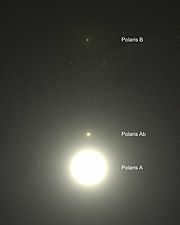
This illustration shows the supergiant star Polaris Aa, the dwarf star Polaris Ab, and the distant dwarf companion Polaris B.
The modern designation for Polaris is derived from the Latin term stella polaris, meaning “polar star,” which was coined during the Renaissance when the star came close to the celestial pole. In 1547, Gemma Frisius named it stella illa quae polaris dicitur (“that star which is called” polar), noting its proximity to the pole of the world at 3° 8′.
In 2016, the Working Group on Star Names (WGSN) of the International Astronomical Union was established to catalog and standardize proper names for stars. The first bulletin of the WGSN in July 2016 included a table of approved names for the first two groups, including Polaris α of the Little Bear Aa.
In ancient times, Polaris was not the nearest star visible to the celestial pole with the naked eye. Instead, the entire constellation of the Little Bear was used for navigation. Polaris eventually moved closer to the pole and became the closest star visible to the naked eye. However, in the early Middle Ages, it was still a few degrees away. As a result, many names referring to this characteristic as Polaris have been used since that time. In Old English, it was known as the “star-ship” or scip-steorra. In Old English runic poetry, the T-rune seems to be associated with the “circumpolar constellation” and the qualities of fortitude and honor.
In Hindu mythology, the concept of the guiding star, known as Dhruva (“still, immovable”), was personified. In the later medieval period, it became linked to the title of Mary of Stella Maris, also known as the “Star of the Sea” (as mentioned in Bartholomeus Anglicanus, circa 1270s). The older English term, recorded from the 14th century, lodestar, meaning “guiding star”, is connected to the Old Norse term leiðarstjarna and the Middle High German term leitsterne.
The constellation of the Little Bear, known as Kinosura in ancient times (derived from the Greek word κυνόσουρα meaning “dog’s tail”), became linked with the polar star, especially during the Early Modern era. The explicit association of Mary as stella maris with the polar star (Stella Polaris), as well as the use of Cyonsura as its name, is evident in the title Cynosura seu Mariana Stella Polaris (meaning “Cynosure, or Mariana Polaris”), a collection of Marian poems published by Nicolaus Lucensis (Niccolo Barsotti de Lucca) in 1655.
In traditional pre-Islamic Arabic astronomy, the constellation was called Al-Judeyy الجدي, and this name was also used in medieval Islamic astronomy. At that time, it was not yet as close to the north pole of the world as it is today and was observed to rotate around the pole.
In Inuit astronomy, the star Polaris is called Niqirtsuituq. It is featured on both the flag and coat of arms of Nunavut, the Canadian Inuit territory, as well as on the state flag of Alaska in the United States.
Measurement of Distance
Stellar parallax serves as the basis for the unit of measurement known as the parsec. A parsec is defined as the distance between the Sun and an astronomical object that has a parallax angle of one arc second. (Please note that the scales of 1 a.u. and 1 pc are not accurately represented in this illustration, as 1 pc is approximately equal to 206,265 a.u.)
Several recent studies have determined that the distance to Polaris is approximately 433 light years (133 parsecs), a value that is in agreement with the parallax measurements obtained from the Hipparcos astrometric satellite. Previous estimates of the distance were slightly smaller, but recent investigations utilizing high-resolution spectral analysis indicate that Polaris may actually be 110 light-years closer (323 svL / 99 pc). As the closest Cepheid to Earth, the precise physical characteristics of Polaris are of great importance in establishing the entire astronomical distance scale. Additionally, Polaris stands out as the only celestial object with a dynamically measurable mass.
| A | 330 light years (101 parsecs). | Turner |
| A | 433 light years (133 parsecs) | Hipparcos |
| B | 359 light years (110 parsecs) | Usenko and Klochkova |
| B | 323 light years (99 parsecs) | Turner et al. |
| A | ≥ 385 light years (≥ 118 parsecs) | Neilson |
| B | 521 light years (160 parsecs) | Bond et al. |
| B | 445.3 light years (136.6 parsecs) | Gaia DR2 |
| A revised set of observations for the years 1989-1993 was initially published in 1997. |
| The preliminary faint distance was used to calculate the statistical distance. |
The Hipparcos spacecraft utilized stellar parallax to conduct measurements from 1989 to 1993, achieving an accuracy of 0.97 milliseconds (970 microseconds). It successfully obtained precise measurements for stellar distances up to 1000 pc. The Hipparcos data has undergone re-evaluation utilizing more advanced error correction and statistical methodologies. Despite the benefits of Hipparcos astrometry, concerns have been raised regarding the accuracy of its Polaris data, particularly in measuring double Cepheids like Polaris. The specific reduction of Hipparcos data for Polaris has been revised and validated, although a consensus on the distance has yet to be reached.
The next major milestone in high-precision parallax measurements is the Gaia mission. Launched in 2013, this space-based astrometric mission aims to measure the parallax of stars with an astonishing accuracy of 25 microseconds (μas). Originally, Gaia was designed to observe stars fainter than 5.7 star magnitude. However, during the commissioning phase, it was discovered that Gaia has the capability to autonomously detect stars of brightness up to 3. As of July 2014, Gaia routinely processes stars in the 3-20 star magnitude range. For the remaining 230 stars brighter than 3rd magnitude, special procedures are utilized to download raw scan data. Methods are currently being developed to analyze and reduce this data, with the goal of achieving “full sky coverage at the bright end” and standard errors of “a few tens of μsecs”. Notably, the Gaia Data Release 2 does not provide a parallax measurement for Polaris. However, the estimated distance from Polaris B is 136.6 ± 0.5 pc (445.5 sv years), which is slightly farther away than previous estimates but significantly more accurate.
Polaris has historically played a crucial role in the cosmic distance ladder due to its status as the sole Cepheid with available direct distance data, which has had a significant impact on distance measurements that rely on this particular “ruler”.
Historical Observations
| Ptolemy (~169) | Yes |
| Al-Sufi (964) | Yes |
| Al-Biruni (~1030) | Yes |
| Khayyam (~1100) | Yes |
| Nasir al-Din al-Tusi (1272). | No |
| Ulugbek (1437) | Yes |
| Copernicus (1543) | Yes |
| Schoener (1551) | Yes |
| Brahe (1598) | Yes |
| Brahe (1602) | Yes |
| Bayer (1603 ) | Yes |
| De Houtman (1603) | No |
| Kepler (1627 ) | Yes |
| Schiller (1627) | Yes |
| Holly (1679) | No |
| Hevelius (1690 ) | Yes |
| Flamsteed (1725) | Yes |
| Flamsteed (1729 ) | Yes |
| Baude (1801a) | Yes |
| Bode (1801b) | Yes |
References
External links
| Wikimedia Commons has media files on Polaris. |
Coordinates: 02 31 48.7, + 89° 15′ 51″.
Polaris indicates the north pole of the world and is situated in the constellation Ursa Minor, specifically in its tail, which is the outermost part. Polaris can be located in the sky by using the Big Dipper constellation, which is much more prominent and well-known to many.
Having the knowledge of how to locate Polaris in the sky is always beneficial, as it is one of the fundamentals of orienteering in the terrain. Once found, it can precisely determine the direction of north and consequently, the other cardinal directions. In astronomy, Polaris is utilized for aligning the equatorial mount, as it remains stationary in the sky during the Earth’s daily rotation.
Polaris is renowned for its unique position, making it one of the most well-known stars. It’s a great idea to educate your children about Polaris and help them locate it in the night sky. While many children may have heard of Polaris, they may not know exactly where to find it, so this information will expand their knowledge and understanding.
Locating Polaris in the night sky
The easiest way to locate Polaris is by using the Big Dipper. This well-recognized constellation is visible year-round in the northern hemisphere. It’s important to note that the positions of constellations change throughout the year due to the counterclockwise rotation of the celestial sphere. Therefore, in winter, the Big Dipper is closer to the horizon, in spring it appears “on the tail” to the east, in late spring it’s nearly at the zenith, and in summer it begins to descend in the west.
Although it has a similar shape to a dipper, the Little Dipper is not as prominent and its stars are not as bright. This is why it is always easier to locate the Big Dipper first.
After finding the Big Dipper, Polaris can be easily located by drawing an imaginary line through the two outermost stars of the Big Dipper’s bucket and extending it further. Polaris can be found at a distance approximately five times longer than this line.
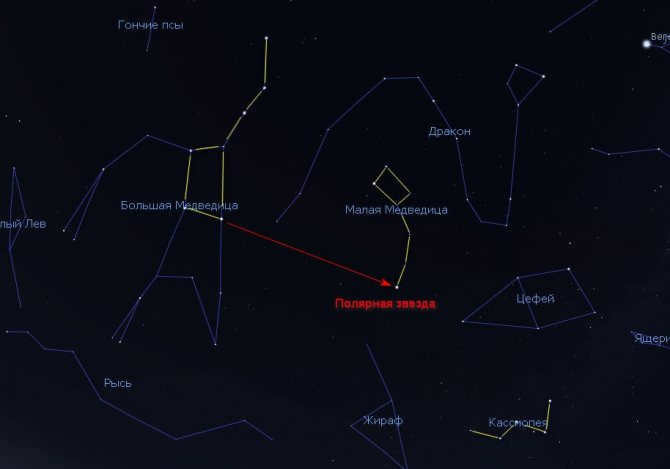
Discovering Polaris in the night sky with the help of the Big Dipper.
Close by lies another highly prominent constellation, Cassiopeia, which takes the shape of a grand letter W. On occasion, this constellation, due to its intriguing form, is the initial one to capture your attention, and subsequently, locating the Big Dipper becomes effortless.
The Little Bear constellation
The Little Bear occupies an area of approximately 255.9 square degrees and boasts a total of 25 visible stars, subject to favorable weather conditions. Previously, the constellation’s prominent star, Kohab, held a closer position to the North Pole. Before Kohab, the alpha star of the Dragon constellation, Tuban, occupied that spot. Interestingly, the Little Bear’s “bucket” changes its orientation depending on the season. In the winter, it is positioned in the west with the handle facing upwards, while in the spring it stands vertically with the handle pointing downwards.
Did you ever wonder about the distance between the Sun and Venus?
In urban areas, only 3 stars from the Little Bear constellation are visible to the naked eye, while the remaining 4 stars are significantly fainter and rarely observed. The Lesser Bucket maintains a relatively consistent position throughout the year.
Can you guess in which constellation Polaris is located?
What Makes Polaris So Popular
When you first spot Polaris in the night sky, you might feel a bit let down – it doesn’t really stand out from the hundreds or thousands of other stars. Many people mistakenly believe that it looks somehow special – perhaps brighter or with a different color. In reality, it’s just an ordinary star with a brightness rating of +1.97m, which puts it at a rather modest 50th place on the list of brightest stars.
However, Polaris is famous for something else entirely. It happens to be located near the Earth’s North Pole, so it almost perfectly points north – deviating by less than 1 degree. For centuries, people have relied on Polaris to navigate their way across land and sea, using it to plot their routes.
Using Polaris for orienteering has been a longstanding tradition.
Polaris can be found in the direction of the North Pole of the Earth.
As the Earth rotates daily, all the stars complete a full revolution in the sky. However, Polaris remains stationary. This is because it is located precisely along the north-south axis, which serves as the axis of rotation for the celestial sphere.
When taking a photo with a slow shutter speed, you can capture this phenomenon. Each star will leave a trail as it moves across the sky, except for Polaris, which will remain in the center without any movement.
Thus, Polaris holds a unique position and possesses significant significance, despite its lack of visual appeal. Interestingly, the southern hemisphere lacks any comparably luminous stars in close proximity to the south pole of the globe. Therefore, individuals residing in the northern hemisphere are fortunate in this regard, as they have a dependable celestial landmark.
Debunking the Myths Surrounding Polaris
Polaris, also known as the North Star, has been the subject of countless myths and legends throughout history. This celestial body possesses a myriad of characteristics that have fascinated and intrigued people from all walks of life. It serves as a guiding light in the night sky, providing direction to sailors and wanderers alike.
In Greek mythology, Polaris is believed to be the son of Zeus – Arcadus, the god of thunder. However, despite the long-standing relationship between mankind and this celestial wonder, there are numerous misconceptions surrounding it:
- The belief that the North Star never sets below the horizon is accurate. However, it is incorrect to say that it does not move. In reality, the axis of rotation of the celestial body aligns perfectly with that of the Earth, resulting in them always occupying the same position.
- The North Star’s position relative to the horizon will vary depending on one’s location along the hemisphere. As one moves closer to the equator, they will notice Alpha gradually sinking closer to the horizon.
- The misconception that the North Star is the brightest star is inaccurate. If one were to search for this attribute, they would be unlikely to find it, as it only ranks 48th in terms of brightness among all known stars. In the northern hemisphere, it is more likely to confuse Sirius or Vega as the brightest stars.
Over time, the Earth’s polar axis undergoes precession, which means it moves in a circular motion with a radius of 23 degrees and shifts by 1.397 degrees every 100 years. As a result, different stars periodically appear in the direction of the North Pole. Currently, the closest star to the pole is Polaris, but this will not always be the case.
Even now, Polaris is not precisely at the pole – there is a small deviation of less than a degree. However, by 2102, this deviation will decrease to only 27 angular minutes, marking the closest position of Polaris to the pole. After that, it will gradually move away from the pole.
The precession of the Earth’s axis is illustrated in the image from Wikipedia.
5,000 years ago, the polar star was Alpha Tuban in the constellation Draco. In 12,000 years, the polar star will be Vega, one of the brightest stars in the sky.
Position in relation to the cardinal directions
When facing Polaris, one will see north in front of them. South will be behind them, west to their left, and east to their right. However, this method will not work at the North Pole, so other techniques must be used for navigation.
Location of Polaris in a constellation
To verify the accuracy of the directions, a camera with a high shutter speed can be used. If the camera is pointed towards the sky, it will show that all objects are moving, creating curved lines in their trajectories. However, the polar star, which is part of a constellation, will remain stationary. This can be used to determine any compass errors.
Have you seen: Constellation Clock (Latin: Horologium, Hor)
The elevation of the brightest point in the sky varies depending on the latitude. At different latitudes, the height of the point differs. In regions near the equator, the point is almost parallel to the horizon. Conversely, at the North Pole, the point is directly overhead. This specific point can be used to determine the latitude of a given location. The measurement is based on the distance to the horizon, measured in degrees.
However, it is important to note that not all locations can accurately determine latitude using this method. For instance, if an individual is in a mountainous or low-lying area, the measurement will be distorted. To obtain an accurate reading of the constellation Polaris, one must be at sea level.
Understanding Polaris
After learning how to locate Polaris in the night sky, you may be curious about the nature of this unassuming yet highly significant star. Polaris is actually a fascinating and extraordinary celestial body. If you were to travel there, you would be astounded by the phenomena occurring within the Polaris system.
First and foremost, Polaris is situated approximately 447 light years away. The light you observe when gazing at Polaris departed from its source during the latter half of the 16th century. It is worth recalling that during this era, the Ottoman Empire was capturing the island of Cyprus, Christopher Columbus had recently discovered America, and European colonizers were beginning to explore and settle its coastlines. Just a few years later, Ermak would embark on his conquest of Siberia, Russia would be engaged in various conflicts, and France would experience the infamous St. Bartholomew’s Day Massacre. Thus, the light you witness originated in the depths of Polaris during these tumultuous times.
Polaris is an extraordinary triple system. The primary component is an immensely powerful supergiant, shining 2000 times brighter than the Sun and boasting a staggering mass 6.5 times greater, as well as a size 50 times larger! This stellar marvel is a youthful star, with an age of merely 55-65 million years. It goes by the name of Polar A.
Located a mere 18.5 astronomical units from this awe-inspiring supergiant, there resides another star, which weighs in at a modest 1.26 times the mass of the Sun. It gracefully orbits around its magnificent companion in a cycle of 30 years. Given their close proximity, capturing an image of this stellar pair was only made possible through the utilization of the remarkable Hubble Space Telescope.
Even more distant, positioned at a distance of 2400 astronomical units from the primary star, there lies yet another celestial entity – Polaris B. This star boasts a mass 1.39 times greater than that of the Sun. It gracefully completes its orbit around the primary star over the course of 100,000 years. Remarkably, this particular stellar spectacle can be observed using an amateur telescope.
Polaris is an incredibly peculiar celestial object. It is a system consisting of three stars that are physically connected to each other. Each of these stars is larger than our own Sun, and one of them is even a pulsating supergiant.
Now that you have learned how to locate Polaris in the night sky, you also have a better understanding of what it actually is. Make sure to spot it during your stargazing sessions and remember all the fascinating facts you have read about this enigmatic entity in the vast cosmos. And don’t forget to share this knowledge with your children as well.
The Small Bear in the celestial sphere
The Small Bear can be found in the vicinity of the polar region and can be observed throughout the year in the northern hemisphere. It is officially known as Ursa Minor, or UMi. The arrangement of its stars resembles a “ladle” similar to the Big Dipper, although the “handle” is curved differently.
In the celestial sphere, the Little Dipper is positioned in the north. The final star in its tail is Polaris, which remains stationary. Its altitude above the horizon, measured in degrees, corresponds to the latitude of the observation location. Thus, Polaris not only indicates the direction towards the north, but also enables accurate determination of one of its coordinates. The Phoenicians were astute enough to recognize and utilize this characteristic, giving them a significant advantage at sea for over a millennium.
The Small Bear in the celestial sphere. Position on January 1st.





